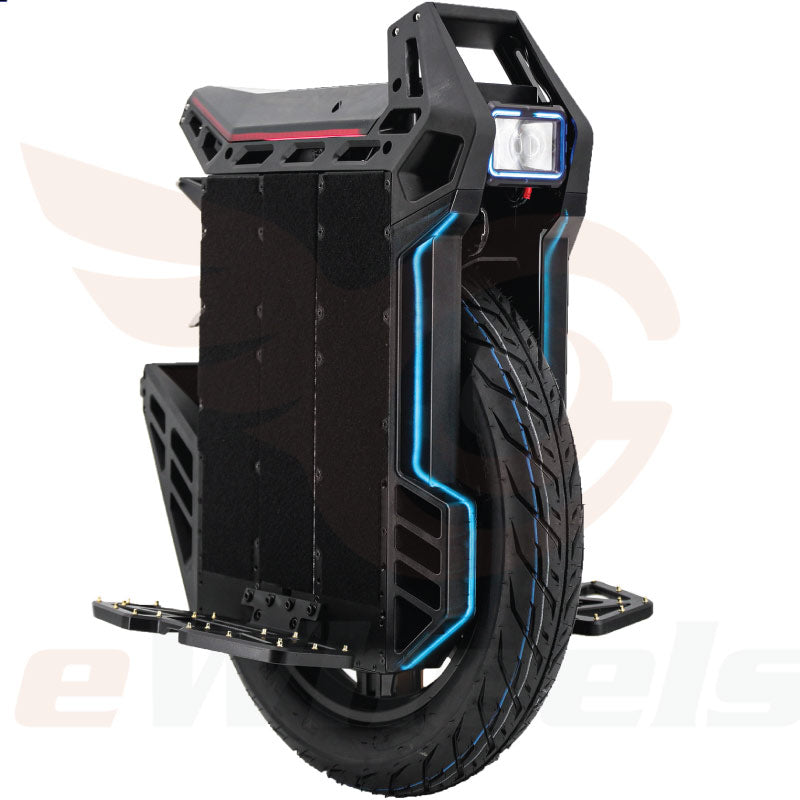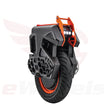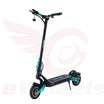






Begode Blitz, 2,400Wh Battery/3,500W Motor (8.5KW Peak)
- In Stock and shipping now! Each Blitz will come with a set of Beidou power pads.
- Weight: Begode's principle objective with the Blitz was to produce a 'ground-up' new design with a total emphasis on weight reduction. Comparing the previous generation Master V4 (94.8lb), the Blitz (79.1lb) shedding 15.7lb, while packing in several new important technological developments
- Motor: 3,500W (8KW peak) high-torque motor. With the first ‘no-load’ spin rate of 93.2MPH. Our production has the upgraded SKF 6012 bearings preinstalled.
- Battery Pack: high-power Samsung 50S 2,400Wh/134V battery pack, with SmartBMS, capable of rapid-charging to 20A/2,680W
- Electronics: latest generation controller (now with data-logging!), charge-board, all new display
-
Suspension: building on the success of the in-house designed DS200 shock, the latest DS210-65A is an air variant, with limitless customizability for each Rider's requirements. Also available with the upgraded Hou X-Linkage coil suspension upgrade kit preinstalled, which uses a superior geometry and the popular DNM RCP-2S coil shock.
-
Tire: Choice of either the LC320 tubeless (street) tire & CST C-186 (knobby). For an added cost, we can install either a tubeless street or knobby tire from TNT, the same that are offered on the Sherman-L. The TNT tubeless knobby tire mimics the Shinko 244 tread pattern, and the TNT tubeless street tire mimics the Michelin City Grip tread pattern.

NEW: Hou CNC X-Linkage/DNM Shock Kit Upgrade
The new Hou Ningning CNC linkage kit unleashes the full suspension potential of the Blitz. Fitted with DNM RCP-2S coil shock, a set of CNC 6061 alloy linkages, which combined provide the smoothest, predictable & greatest range of travel that this model has to offer. If ordering with the Wheel, we will preinstall this at no extra cost before shipping out your order.


Achievement of Weight Reduction
The chief highlight of the Blitz is its 15.7lb weight reduction over the early generation Master V4, while packing in a number of notable upgrades: SmartBMS, upgraded charge-board, all new display, customizable surround LEDs, best-of-class suspension, tubeless tire, SKF bearings, more power & speed.
This was achieved through the extensive use of magnesium alloy for the motor, battery boxes & other structural materials. Every component has been thoroughly examined to determine the optimal trade-off between strength & producing the lightest machine of this class ever released.

All New Display

Illuminated 6-point Dash
The new 5th generation display now has 6 unique data-points, all the essential information available at a glance of the eye. Until now, Begode displays had an imprecise 4 block bar-indicator for the battery level, which was not ideal for estimating, with some degree of precision, how much capacity was remaining in the pack. With the voltmeter, this takes a lot of the guesswork out of the equation. The illuminated display is visible in most lighting conditions, including direct sunlight.
Frequently Asked Questions
What are the advantages of the Blitz over the Master V4?
Could the Blitz have been a 168V Wheel?
What charger is included with the Blitz? Is it rapid-charging capable?
What is a realistic maximum cruising speed for the Blitz?
Can the LED light scheme be customized to different schemes?
Have any other notable hardware improvements been made to the Blitz?
The Blitz will reportedly offer GPS tracking, is that true?
What is the maximum rider weight that the Blitz can support?
What accessories are available for the Blitz? Will it come with power pads?
How weather-resistant is the Blitz?
NEW: Upgraded Samsung High-Power 50S Battery Pack
The most valuable component of any Wheel is its battery pack, the beating pulse of the machine. Over the years it has been found, from painful experience, that pairing a high-powered machine with a battery cell that is not designed for high peak-power applications can result in latent/delayed catastrophic thermal runaway events. To try to minimize this risk, we at eWheels, have insisted the use of high-powered battery cells, particularly on smaller 4 parallel packs, such as the MTen4, A2, T4, S18, Hero, S22, & Master—as the number of parallels increase, the load on each cells decreases accordingly. Until recently, there was the trade-off between power & capacity; now, with the advent of the new Samsung 50S cell, one can have both!
- Energy Density: 50S has a 20% increase in energy density over the 40T, providing a corresponding increase in range without any weight/bulk penalty.
- Higher Operating Temperatures: the specifications of the 50S has a vast operating range, from -20 to 80°C/-4 to 176°F vs -20-60°C/-4-140°F with the commonly used 50E/GB cell & as high as 100°C/212°F in Samsung’s test data! This massive margin not only allows the 50S to output up to 3x more power than the 50E, but perhaps more importantly, will greatly improve battery pack safety, there is no conceivable scenario in which these limits will ever be reached, or exceeded.
- Power Output: the maximum sustained power output on the 50s is 45A vs 15A on the 50E. From a Rider’s perspective, the main benefit of having this power on-tap is once the pack(s) have been partially depleted, reducing the risk of cut-outs when power is required.
- Rapid-charging: another benefit of the 50s over the 50E is charging rates, 2.25x higher, 6A vs 2.5A. The Blitz is rated for a max charge rate of 20A, but most will only be able to achieve 11A on a common household circuit before blowing the breaker, a 240V circuit will allow for the full 20A charge rate.
- Superior Cycle-life: perhaps the most common misconception of high-power cells is that of reduced cycle-life, but this is fundamentally a misunderstanding of the published datasheet for battery cells. In these publications, Samsung’s data is based on exceedingly high sustained loads of 25A/45A. Other Samsung materials demonstrates that in 10A continuous load scenario, the 50S commands a slight lead over the the 50E for longevity, with >82% capacity retention over 600 cycles.
It should also be noted that these synthetic tests in no way represent the power demand pattern that is experienced when using your machine, where the average load, on flat terrain, will be closer to 2-3A/cell vs the 10A in the test data—there may be periods where this demand is considerably more than the 10A, which is where the high-power cells really come into their element. In addition, the [50S] 600 cycles were charged at the maximum 6A vs a typical 1.5A (per parallel) with the stock charger, which also has an impact on the pack’s longevity.
In summary, the 50S battery cell is objectively superior in every measurable metric, with only a marginal increase in upfront cost. It is expected that machines fitted with these packs will retain their value better than other battery cells.


Blitz Photo Gallery
















